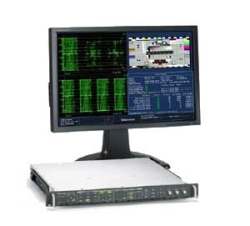Apr 8 2010
Tektronix has announced recently that it is the only supplier who provides a solution that covers everything from RF Ingest to Edge, which helps to tackle the range of challenges faced by the Telco and cable operators while managing artifact detection and impairment issues of their networks.
 Tektronix Video Test Equipment
Tektronix Video Test Equipment
Tektronix has incorporated novel Quality of Experience (QoE)-based detection capabilities in its best-in-the-industry range of IP and RF network probes. This will help Tektronix to increasingly focus on empowering Telco and cable operators to cost-effectively and reliably provide the best possible experience for their viewers.
Cable operators are under increasing pressure for providing a viewing experience of a high quality, more so with the fast proliferation of HD channels, which result in challenges in bandwidth management. Under such a scenario they are considering better and cost-effective methodologies for the detection of consumer impact on content impairments. On of their proposed strategies is focusing on monitoring QoE, besides the more customary QoS. Tektronix’s QoS MPEG products portfolio has won the Emmy award. These products and its large baseband video test expertise is integrated in new QoE capabilities for empowering Tektronix to focus on innovation for meeting the QoE test requirements of Telco and cable operators.
The salient parts of the end-to-end solution of Tektronix solution include the VQNet, which is a Network Element Management System, and a range of network probes. These probes and the related video quality test points incorporate the MTM400A with DVB-S2 or QPSK for Ingest; the QAM400A for QAM gadgets, the IPM400A along with GiGe for IP delivery system and the RFM300 along with 8VSB for Ingest.
The Tektronix range of network probes that incorporate techniques related to specialized impairment detection and visualization help operators to speedily detect problems that impact the viewer’s experience and accordingly initiate measures for detecting and resolving the problem. To determine the main cause of network problems QoS monitoring is essential. Without QoE monitoring, the operator cannot easily find out the QoS problems that impact the viewing experience. Operators can utilize Tektronix’s dependable, objective compression artifact detection features for avoiding the cycle to resolve events that are non-customer impacting and provide superior quality easily.
The VQS1000 Video Quality software forms the core of the QoE detection capabilities. This software can be integrated with any network probe of Tektronix for enabling H.264 or MPEG-2 video encoded content impairments assessment in real time. The impaired content includes compression artifacts for particular services, and blockiness, stuck, and black impairments. The software enhances the accuracy and reliability of artifact measurement significantly through conducting a complete decode of the video stream. The complete decode permits operators to find out whether the origin of a problem lies in the content source like over-compression or in the network distribution. In this top industry solution, engineers will be able to observe clearly and authenticate the impairments present in the image by utilizing specialized impairment displays that depict the severity and the location of the video defects.
It is possible to generate alarms having configurable impairment frequency, duration, and magnitude thresholds for alerting the users to content impacting the viewing experience of customers, and also capture the impaired content. When alarms are integrated with Tetronix’s IPM400A or any other MTM400A series probe, operators will be able to find out whether the problem source exists in the content, such as in the case of over-compression, or the distribution layers of the network. It is possible to use the VQS1000 continuously for assessing a particular service for extended time periods, along with logging of average, max, and min measured values of QoE parameters and related bit rates. This information can be used by the engineers for the identification of systematic issues that are difficult to track down otherwise and also optimize equipment and network configuration settings for delivering the best possible viewing experience within their customers’ bandwidth constraints.